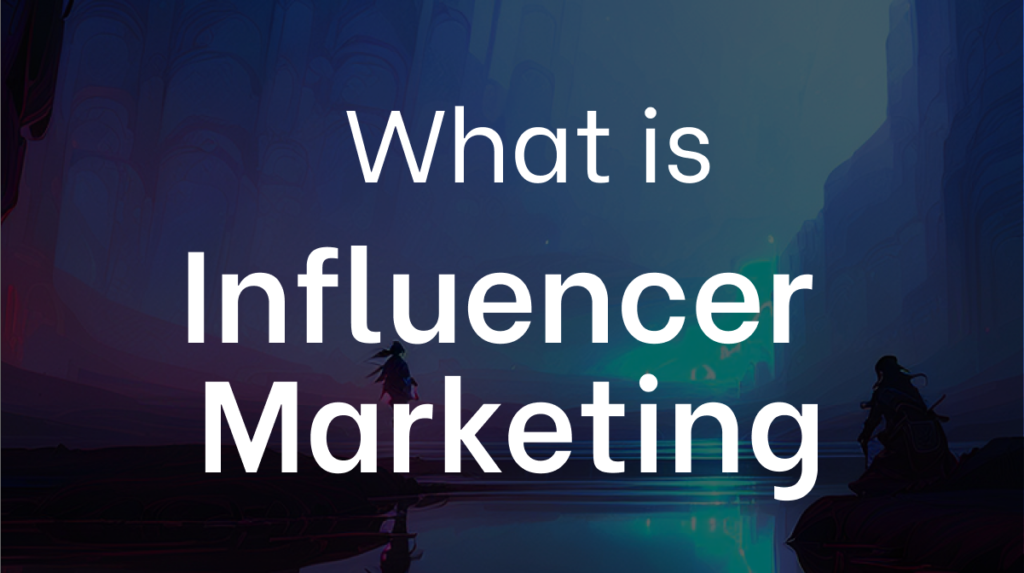Influencer marketing has become one of the most popular in marketing tactics and strategies in recent years. It involves partnering with individuals who have a significant following on social media platforms, such as Instagram and YouTube, to promote products or services. This type of marketing tactic has proven to be effective, with a survey by Mediakix showing that 89% of marketers found influencer marketing to be successful.
In this article, we will take an in-depth look at what influencer marketing is, its benefits and challenges, the process involved in influencer search, and best practices for executing a successful influencer marketing campaign. We will also explore some successful examples of how influencer marketing works and discuss the future of this marketing strategy.
Types of Influencer Marketing

Influencers come in different categories based on their number of followers, audience size, and niche. The four main types of social media influencers are celebrity influencers, macro-influencers, micro-influencers, and nano-influencers
Celebrity Influencers
These are influencers who have a massive following of over one million on social media platforms. They are usually popular personalities, such as actors, musicians, and athletes, and celebrity influencer endorsements are often used by big brands for endorsement deals.
Macro-Influencers
These influencers have between 100,000 to one million followers on various social media channels and platforms. They are usually experts in their respective fields and have a strong influence on their followers.
Micro-Influencers
These influencers have between 1,000 to 100,000 followers on social media platforms. They are usually everyday people who have built a loyal following in their respective niches, such as fashion, beauty, and fitness. Micro-influencers are often more engaged with their followers and have a higher rate of audience interaction
Nano-Influencers
These influencers have between 500 to 1,000 followers on social media platforms. They are usually friends, family, or acquaintances who have a small but engaged following. They are often used research influencers for hyper-targeted campaigns, such as local businesses or niche products.
The Role of Influencers in Marketing
Influencers play a critical role in marketing by helping brands build trust, amplify their brand message, drive sales and conversions, further brand awareness campaigns and enhance customer engagement and loyalty not all campaigns.
Building Trust and Credibility
One of the key benefits of influencer marketing is that it helps brands and mega influencers to build trust and establish credibility first with their target audience. Influencers have built a loyal following who trust their opinions and recommendations. By partnering with influencers, brands can leverage this trust and credibility to increase brand awareness and loyalty.
Amplifying Brand Awareness and Visibility
Influencers have a massive reach, and partnering with them can help brands increase their visibility online influencers and reach new audiences. Influencers can create authentic and engaging branded content, that resonates with their followers and helps increase brand awareness.
Driving Sales and Conversions
Influencer marketing can be an effective way to drive sales and conversions for brands. Influencers can promote products or services to their followers, through online ads and this can lead to increased sales and revenue for the brand.
Enhancing Customer Engagement and Loyalty
Influencers have a strong connection with their followers, and by partnering with influencer marketing examples for them, brands can increase customer engagement and loyalty. Influencers can create content that sparks engagement, such as giveaways or Q&A sessions, for niche content creators and this can help increase customer loyalty.
Read more:
The Influencer Marketing Process

The influencer marketing process involves several steps, including identifying and researching influencers, planning and executing influencer campaigns, measuring and analyzing influencer marketing ROI, and managing and maintaining influencer relationships.
Identifying and Researching Influencers
The first step in the influencer marketing process is to identify and research potential influencers who align with your brand and target audience. This can involve using tools like Google and social media platforms to find influencers in your niche. Once you have identified potential influencers, you should research them to ensure they align with your brand values, have a genuine following, and have engaged audiences.
Planning and Executing Influencer Campaigns
After identifying and researching potential influencers, the next step is to plan and execute your influencer campaign. This involves defining your goals and objectives, developing a budget, and creating a campaign brief that outlines your expectations, deliverables, and timelines. You should also establish a communication plan with the influencer to ensure that both parties are on the same page.
Measuring and Analyzing Influencer Marketing ROI
Measuring and analyzing the ROI of your social media influencer and marketing campaign is crucial to determine its success and identify areas for improvement. You can use tools like Google Analytics and social media analytics to track metrics such as engagement rates, reach, and conversions. You should also conduct surveys and collect feedback from customers to gauge their satisfaction and perception of the campaign.
Managing and Maintaining Influencer Relationships
Building and maintaining strong relationships with influencers is essential for successful influencer marketing campaigns. You should communicate regularly with the influencer, provide them with feedback and support, and compensate them fairly for their work. Building long-term relationships with influencers can also help establish brand loyalty and trust with their followers.
Best Practices for Influencer Marketing

To execute a successful influencer marketing campaign, it’s essential to follow best practices that ensure you get the most out of your investment. Here are some best practices for create an influencer marketing
Define Your Goals and Objectives:
Before starting your influencer marketing campaign, it’s important to define your goals and objectives. This will help you develop a campaign strategy that aligns with your brand values and target audience.
Partner with the Right Influencers:
Partnering with the right social influencers, is critical to the success of your social media marketing campaign. You should research and vet potential influencers to ensure they align with your brand values, have a genuine following, and have engaged audiences.
Develop a Clear Campaign Brief:
A clear campaign brief is essential to ensure that both you and the influencer are on the same page. It should outline your expectations, deliverables, and timelines.
Leverage Authentic Content:
Authenticity is key in influencer and marketing efforts. Influencers should be encouraged to create content that aligns with their personal brand and resonates with their followers.
Be Transparent and Compliant:
Transparency and compliance are critical in influencer marketing. You should disclose any sponsored content and ensure that your influencer campaigns comply with FTC guidelines.
Challenges of Influencer Marketing

In recent years, influencer marketing has become a popular strategy for brands looking to reach new audiences and drive business results. However, with influencer marketing guide its rising popularity come challenges that brands must navigate to ensure successful campaigns. In this article, we will explore the challenges of influencer marketing and provide insights on how to overcome them.
Finding the Right Influencers for Your Brand
One of the most significant challenges of influencer marketing is finding the right influencers for your brand. With so many influencers to choose from, it can be overwhelming to identify the right influencer, ones that align with your brand values and resonate with your target audience.
To overcome this challenge and identify influencers, it’s important to conduct research and vet potential influencers thoroughly. Look at their content, engagement rates, and audience demographics to ensure they align with your brand values and have an engaged following. It’s also essential to consider the type of content the influencer creates and ensure that it aligns with your brand message.
Additionally, consider partnering with micro-influencers, who have smaller but highly engaged audiences. Micro-influencers can be a cost-effective way pay influencers to reach niche audiences and can often provide higher engagement rates than macro-influencers.
Managing Influencer Relationships and Expectations
Building and maintaining strong relationships with influencers is critical for the success of influencer marketing campaigns. However, managing these relationships and meeting expectations can be a challenge for brands.
To overcome this challenge, it’s important to establish clear expectations from the outset. Develop a campaign brief that outlines your expectations, deliverables, and timelines. It’s also essential to communicate regularly with the influencer and provide them with feedback and support. Building long-term relationships with influencers can also help establish brand loyalty and trust with their followers.
Ensuring FTC Compliance and Transparency
Ensuring FTC compliance and transparency is a critical challenge for brands engaged in influencer marketing. The FTC requires influencers to disclose any sponsored content or paid partnerships, and failure to do so can result in fines and legal action.
To overcome this challenge, it’s essential to develop a transparent influencer marketing campaign that complies with FTC guidelines. Disclose any sponsored content and ensure that your influencers understand the importance of transparency. It’s also important to stay up to date with any changes in FTC guidelines and adjust your campaigns accordingly.
Measuring and Proving ROI
Measuring and proving the ROI of influencer marketing campaigns is another challenge that brands face. It can be challenging to track the impact of what is influencer marketing campaigns and determine their effectiveness in driving business results.
To overcome this challenge, it’s essential to define your own marketing goals and objectives from the outset. Establish key performance indicators (KPIs) that align with your business objectives and use tools like Google Analytics and social media analytics to track metrics such as engagement rates, reach, and conversions.
Additionally, consider conducting surveys and collecting feedback from potential customers to gauge their satisfaction and perception of the campaign. By measuring and analyzing the ROI of your influencer marketing campaigns, you can identify areas for improvement and optimize your future campaigns accordingly.
Avoiding Influencer Fraud and Fake Followers
In recent years, influencer fraud and fake followers have become an increasingly significant challenge for brands. Some influencers may use tactics like buying followers or engagement to boost their credibility, but this can lead to inflated metrics and ineffective campaigns.
To overcome this challenge, it’s essential to vet potential influencers thoroughly and look beyond vanity metrics like followers and likes. Look at engagement rates, audience demographics, and the authenticity of influencer posts their content to ensure they have an engaged and genuine following. Additionally, consider using influencer marketing platforms that offer fraud detection and verification to ensure that you are partnering with authentic influencers.
Successful Examples of Influencer Marketing

Influencer marketing can be a powerful form of promotion, with its potential to reach an incredibly vast audience. Let’s take a look at some successful examples of influencers who have made an impact for their brand partners.
Nike’s “Dream Crazier” Campaign
Nike’s campaign, featuring Serena Williams as its main spokesperson, exemplified the power of an influencer marketing strategy. The company created a short video with the mission to inspire women to be fearless and follow their dreams with tenacity, regardless of social conventions. It featured interviews with several high-profile female athletes most influencers and was shared across social media platforms, reaching millions of viewers.
Glossier’s “Into the Gloss” Blog
Glossier created an online platform called Into the Gloss that featured interviews with influential women along with product reviews and tips for makeup application. Rather than step into the traditional world of advertising, Glossier used influential personalities to raise awareness about their brand amongst their target market: hip millennials who appreciate individualism and minimalism.
Daniel Wellington’s Instagram Campaign
Daniel Wellington struck gold when they implemented a successful Instagram campaign featuring fashion influencers wearing their watches as part of their everyday outfits. The images were professional quality and posted on Daniel Wellington’s Instagram account but also on other influential accounts, helping to increase the watch designer’s brand exposure both dramatically and win over new customers too.
Airbnb’s Instagram Influencer Program
Airbnb enlisted twenty popular instagrammers from around the world and sent them on trips in order to post beautiful cabin-style photos taken in various parts of the globe. The goal was to highlight Airbnb’s most inspiring locations as well as help people
The Future of Influencer Marketing

Influencer marketing is here to stay, with continued growth and evolution projected for the industry. Companies are increasing their focus on influencer marketing hub and on micro and nano-influencers, who have more direct influence on smaller fan bases. There is an emphasis on authenticity and transparency, with influencers expected to be completely honest in their reviews of other brands’, products and services.
In addition, influencer marketing is no longer an isolated avenue for businesses – it is being integrated into other marketing channels and strategies. Influencers can be used to reach out to new target audiences via social media platforms, as well as to increase increased brand awareness and visibility online. This integration allows businesses to leverage the most effective aspects of influencer marketing while simultaneously boosting their brand’s reputation in the digital marketplace
FAQs
What is influencer marketing and why is it so important to marketers?
Influencer Marketing helps a big brand get to know a bigger audience by increasing brand awareness and their visibility, and offers better results than other marketing methods.
How does influencer marketing work?
Influencer marketing is a method of advertising by which businesses partner with people whose followers have large social media following through paid promotional activities. A customer will act as “a regular” face for a particular service or product for the brand to attract attention from the consumer.
What defines an influencer?
Influencers are those with influence on your target market. Influencers possess expertise or insight in certain subjects.
Conclusion
Go ahead and get started with influencer marketing – it’s a great way to promote your brand and reach a wider audience. As you’ve learned, it can be quite a successful marketing strategy if implemented properly.
When it comes to influencer marketing, the key is to pick content creators who genuinely believe in your brand and understand the niche they’re operating in. Doing this will ensure that their advocacy of your product is genuine and not just an advertisement in disguise.
Finally, don’t be afraid to experiment – try out different types of influencers from different industries, different content styles and formats. Doing so will let you understand what works best for you and your target audience, helping you refine your influencer strategy for maximum effectiveness.

